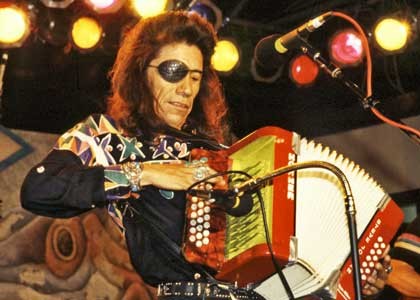Editor’s Note: The following is an excerpt from Michael Corcoran’s new book, All Over The Map: True Heroes of Texas Music, published by University of Texas Press
When he walked onstage at the 20th anniversary of the Tejano Conjunto Festival at San Antonio’s Rosedale Park in May 2001, Steve Jordan was resplendent in a purple jumpsuit with gold buccaneer sleeves. But what stood out most was how frail the 62-year-old accordion legend looked. Like a skeleton clinging to its last layer of skin, Jordan appeared so gaunt that his right eye patch seemed to cover half his face. A stray strand of his jet-black mane stuck to his lips, giving this cholo pirate an even more eerie look as he strapped on a red diatonic button accordion bearing his name.
Then came the smile, that ear-to-ear endorsement of the moment. To other entertainers, a grin is a given. But on the mouth of a pioneer prone to bitterness, who generally limits his public performances these days to weekends at Saluté, the upturned corners meant something.
| Esteban Jordan: A wild maverick who refuses to let the music industry touch his art. |
It’s not often that an enigma comes to life before your eyes, so when “Estay-bon Hor-don,” as he was introduced, took off on a jazzy tangent to start his set, the audience of about 2,000 erupted. Conjunto purists have not always been fans of Jordan’s attempts to modernize a style of music that peaked in popularity in the ’50s, and he’s not exactly big with the Tejano crowd, which prefers its frontmen to wear cowboy hats and dance around. But on this night the factions of fans blended together to welcome home the nororious troubled genius “El Parche,” the Patch. When he punctuated the perfect night with his trademark girlie yelp, the cowboys in their white straw hats raised their cans of light beer and the women brushed against the upbeat.
“Voy a cantáerles un corrído muy al albla” (“I’m going to sing you a great corrido”) he vocalized on a traditional Mexican folk song that he would “Jordanize” with cat-quick button runs and a skronking solo closer to be-bop than Tex-Mex. “Esta es la historia de un pachuco muy rocote,” he sang in an unharnessed voice.
This is the story of one badass pachuco.
The way you interview Steve Jordan is to just show up at his door. Appointments don’t mean much to the man who’s never owned a watch. He’s been known to take off at the drop of a Hohner on impromptu deep sea fishing and casino gambling vacations off South Padre.
But on this day you’re lucky. It’s four in the afternoon and Jordan’s home, but he’s still sleeping. “He was up all night recording,” his 19-year-old son Steve says. “Give him another hour or two.” A polite and soft-spoken kid, Steve III (he has an older half-brother also named Steve Jordan) gives a tour of the studio that dominates the living room. The only TV is tuned to a surveillance camera outside. The only stereo is a big wooden console number on top of which several Ampex reel-to-reel tapes are stacked. The famous red “Steve Jordan Tex-Mex Rockordeon” is on the floor next to a chair. There are musical instruments everywhere — guitars, drums, saxophones, timbales and two or three other button accordions. Jordan can play them all with the virtuoso skill another man named Jordan once displayed on the basketball court.
“How do you like my little set-up here?” asks the man himself, emerging from a bedroom less than half an hour since the knock on his front door. “You meet my 280 musicians? Right here, man, in my synthesizer. Best musicians I ever jammed with, bro, cause they all play like me.” There’s that exaggerated snicker and the slap on the back. Mr. Jordan’s wearing sunglasses instead of the patch that earned him the nickname “El Parche.”
You don’t need to ask a question to get him to take off on any given subject in his hipster growl. “I hate digital, man,” he says pointing to his ancient reel-to-reel decks. “Music is not this,” he says chopping the air like the vertical coding on CDs. “It’s like this,” he says, rolling his hand in circles.
Steve Jordan doesn’t do interviews, he holds court. He tells stories, recounts old gigs and goes off on riffs, jumping from an explanation of why he used to own a hearse (“I didn’t want my first ride in one to be in the back”) to his assessment of other accordion players (“That dumb cowboy’s pretty good, but he can’t play with me,” he says of one.)
The mention of an article in the San Antonio Express-News which, while acknowledging Jordan’s genius, includes allegations of drug use, brings out a trace of the notorious temper. “I’ll take a dude outside and whip his ass if he disrespects me,” he says. “Society can’t touch me, man. Never has. I never went to school, never been trained how to act. I’m an animal, bro.”
Moments later, Jordan is back to telling funny stories about the early years on the road. If you’re going to keep up with Steve Jordan, you can’t dwell on anything he says or does. “I remember the first time I ever heard of acid, LSD. It was 1964, bro, and the stuff was legal,” he says. “We had just finished playing — it was somewhere in California — and some dude asks the band if we want to do some acid. I said, ‘Sure, I’ll try anything,’ and started rolling up my sleeve. But the dude said, ‘You don’t shoot it, you eat it.’”
Jordan goes on to describe LSD hallucinations so horrifying that he says he swore off acid forever. “At one point, I asked my bass player, ‘What’s that funny-looking thing? What does it do?’ and he said ‘That’s your accordion, man.’ That was it for me. When I couldn’t recognize my accordion, that was way too fucked up.”
He’s been called “the Jimi Hendrix of the accordion” since the late ’60s, when he introduced psychedelic phase shifters to an instrument aligned with The Lawrence Welk Show. He’s also been compared to Charlie Parker — in both talent and temperament, but Jordan doesn’t agree. “Charlie Parker just played jazz. I play jazz, but I also play rock, country, salsa, mariachi, cumbias — you name it.”
| “Society can’t touch me, man. Never has. I never went to school, never been trained how to act. I’m an animal, bro.” – Steve Jordan |
These days, however, Jordan is more like Brian Wilson during his obsessive Smile days. During the last decade, when he snipped his barfly wings and evolved into a studio parrot, Jordan has recorded more than 100 new tracks, stuff he says is 20 years ahead of its time. It’s a heavily layered sound, with Jordan running his guitar notes through a pair of Roland synthesizers to create everything from cellos and violins to otherworldly horn sections. The music of Steve Jordan’s mind is full and offbeat. But despite its inherent trippiness, there’s an unmistakable melodic thrust to the new material, which sounds like ‘60s soul one minute and a loco polka the next. He doesn’t trust a record company to put it out, just as he doesn’t let managers, booking agents or anybody else in the music industry touch his art. He hasn’t released a new album in 12 years.
Jordan gave up the bottle after he fell during his 53rd birthday party and broke his arm. When he turned 54, his friends chipped in and surprised him with a $2,000 synthesizer he’d been pining for. “We created a monster,” says Efraim Palacios, the head chipper-in, of the synthesizer that stimulated Jordan’s non-stop compulsion to record.
“I don’t listen to anybody else,” Jordan says. “I don’t listen to the radio. It’s all crap, man.” In the background is a Christmas song that Jordan recorded so he’d have something to listen to during the holidays.
By his own estimation, Steve Jordan is 125 years old. “When I was a little kid, I couldn’t work in the fields. I couldn’t pick cotton, so I stayed behind in the camp with all the people who were too old to work,” he says. “When I was 7 years old, I was 70 in my mind.”
He began life in the Rio Grande Valley town of Elsa in 1938 with a fire in his eyes. Moments after he was born, a midwife gave him contaminated eye drops which caused scarring and Jordan lost all his sight in his right eye and most of it in the left. He was the runt of 15 children born to migrant-worker parents, but Steve could play every instrument he got his little hands around. His earliest memory is of playing the harmonica as a toddler. He moved on to guitar, bass and drums. One night in a labor camp outside of Lubbock, 7-year-old Jordan was playing guitar and heard a sweet accordion sound coming from the shack next door. “I stuck my head out and he stuck his head out and we decided to play together,” he says. And that’s how Jordan met a teenaged Valerio Longoria, who would go on to join Santiago Jimenez Sr. (Flaco’s dad) and Narciso Martinez in the holy trinity of conjunto acordeonístas. “I had seen people playing the accordion before, but never so close or so good.”
As a teenager in the early ’50s, Jordan saw a demand for dance bands, so he pulled four brothers out of the fields and taught each one their musical role. “That’s how I learned all those instruments,” he says. “When I’d show someone in my band what to play, I was also teaching myself.”
In 1958, Steve settled in San Jose, Calif., and married the great singer Virginia Martinez, who would join him on vocals on several regional hits in the traditional ranchera and polka styles. He was faster, flashier, more versatile than the other accordion players right from the start, but Jordan really opened up, both literally and musically, in 1973 after he was knifed by a stranger whose motive is still unknown. “Getting stabbed really turned me around,” he says of the parking lot assault outside a bar in Roswell, N.M. “I realized that it was time to stop fucking around and just get down all the sounds in my head. Don’t hold back, because life is short.”
You can hear the innovations evolve on the essential Many Sounds of Esteban ‘Steve’ Jordan (Arhoolie), which opens with nine tracks recorded in 1963 with Martinez and ends with an assortment from the ’70s.
During his 1973 hospitalization and year-long recuperation, Jordan often passed the time taking his equipment apart and putting it back together. For years he’d been retuning his accordions by filing the reeds inside, but when he studied the inner workings of an echoplex and perfected various effects, he took conjunto music to a new level. The “invisible genius of Texas accordion music” he was called in a 1992 Option magazine profile by Ben Ratliff, now a jazz critic for The New York Times. The beloved Flaco Jimenez had become the ambassador of conjunto music, but it’s Jordan, who keeps progressing, even if it means shaking a few fans with every zig and zag.
But as with many innovators, Jordan hasn’t achieved the success of many of his imitators. His groundbreaking singles for Corpus Christi-based Hacienda Records in the ’70s rarely sold more than 1000 copies and nobody can remember the last time he had a radio hit. He’s an international dude stuck in a Chicano world, as he told one critic, an expressionist expected to conform to the limitations of a diatonic instrument designed to play in only three keys.
Jordan’s wicked perfectionist streak is such that he once hauled his own PA system to a taping of Austin City Limits. Although he flatly stated that he wouldn’t go on without his own speakers, he finally relented when it was pointed out that the “ACL” system was set up for television taping and not some Tejano bar. Jordan has also been known to be brutal with club sound engineers. “I’m sorry, but white guys just can’t mix Mexican music. They always want to put the emphasis on the beat,” he says, imitating a bass drum. “But we like the upbeat.”
Jordan says reports that he can be a fiery bandleader are justified, but there’s no problem with his current band. “They’re like little pieces of me,” he says of 17-year-old bassist Richard Jordan and the 19-year-old guitarist he calls Steve 3. “These boys, they keep me young. They never complain. They never want to stop.”
| Esteban Jordan and Rio Jordan 10pm Fri, Nov 11 Saluté 2801 N. St. Mary’s 732-5307 |
Steve suddenly stops talking and raises a hand for silence as his version of “Harlem Nocturne” plays in the background. The jazz standard, which Steve spent more than a week producing, starts with a lushly layered orchestra conjuring every shade of the night. “Can you dig it, man?” he asks when his accordion starts into the melancholy melody. “All that sound from this little brown box,” he says, tapping an old Hohner on the floor with his foot. He touches his chest where the buttons would be, swaying his head as if he’s lost in a dream.
“Man, what am I doing here, living in the back of some other dude’s house, with my kids sleeping on the floor?” he asks, cutting into the ethereal moment. “Ask yourself that, bro. But this is why,” he says, gesturing back to the speakers, where his accordion is flitting all around the melody like a bouquet of fireflies. “This,” he says tapping the air. “This.”
What a gift it is, the ability to blow your own mind. For Esteban “Steve” Jordan that’ll have to do for now. •



















